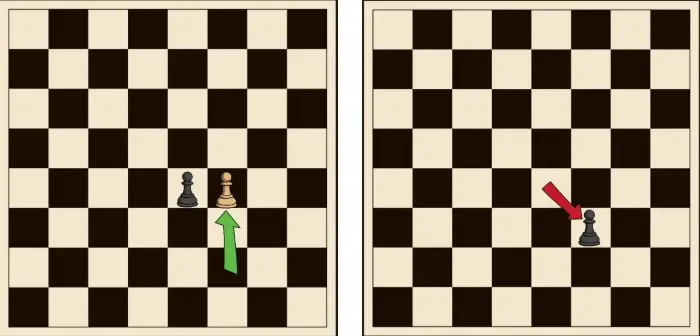The pawn’s movement is very simple, but they are capable of a special move that often causes some confusion—en passant.
It’s not very common. When I learned chess, I wasn’t taught the en passant move, and I don’t think any of the people around me knew it. A lot of casual players don’t know or use this move, but it is still a part of chess. On the other end of the spectrum, some people believe en passant is mandatory. But is en passant forced? Before we get to that and other specific questions, here’s an overview.
What Is En Passant?
This is a special move that allows a pawn to capture a pawn that is directly to the side. To do this:
- Your pawn must be 3 rows away from your opponent’s back row
- Your opponent’s pawn must have moved 2 squares, landing next to your pawn on their last move.
Here’s what it looks like:

First board: The black pawn is 3 rows away from white’s back row. The white pawn moves 2 squares on its first move, landing next to the black pawn. Second board: The black pawn attacks diagonally forward (like always), but it attacks the square behind the white pawn, capturing it. Notice that the capture works as if the white pawn moved only 1 square instead of 2.
To capture like this, it must be done immediately after the other pawn moves 2 squares off its home square, as the white pawn did above. If black moves another piece first, the en passant capture isn’t allowed. If the home pawn moves 1 square ahead, then another square ahead on the next move, this capture isn’t allowed.
Is En Passant Forced?
No. It’s not a forced move. If your pawn is in the right position when your opponent makes a 2 square advance with a pawn, you have the option of making the en passant capture, but only on your next move. The fact that the ability to execute this move is lost by waiting tells us the move is optional. If it was mandatory, waiting wouldn’t be allowed.
The only time an en passant capture is mandatory is the same as when any other non-check response is mandatory—when it’s the only available legal move you have. (passing your turn is not allowed)
Is En Passant Legal?
Yes. It’s a legal chess move. The fact that it looks unusual and some people have never heard of it doesn’t change anything.
When Can You En Passant Capture?
Only when your pawn is on the same rank that an enemy pawn reaches when it advances 2 squares on its first move, landing right next to your pawn. You must make the capture on the move immediately following the 2 square advance. If you make some other move first, the en passant capture is no longer legal.
Can You En Passant Any Other Piece?
No. You can only en passant capture a pawn that has just moved out 2 squares. If any other enemy piece moves into the same position next to your pawn, they can’t be taken in this way.
How Many Times Can You Capture En Passant?
You can make this capture against any of your opponent’s pawns, provided the position is correct. Each side starts with 8 pawns, so the maximum possible amount in a game would be 8. (setting up the board) In the course of a normal game, the opportunity won’t come up 8 times. Your opponent would have to be intentionally moving their pieces to leave themselves vulnerable to this capture that often. The opportunity doesn’t arise much, and in some games, not at all.
What Is the Point of En Passant? Why Does It Exist?
It exists so a pawn can’t bypass an enemy pawn with a 2 square advance. This move wasn’t introduced until after the introduction of the 2 square option on the first pawn move.
So, is en passant forced? No. I hope this has cleared up any confusion you had about this unusual move in chess.
